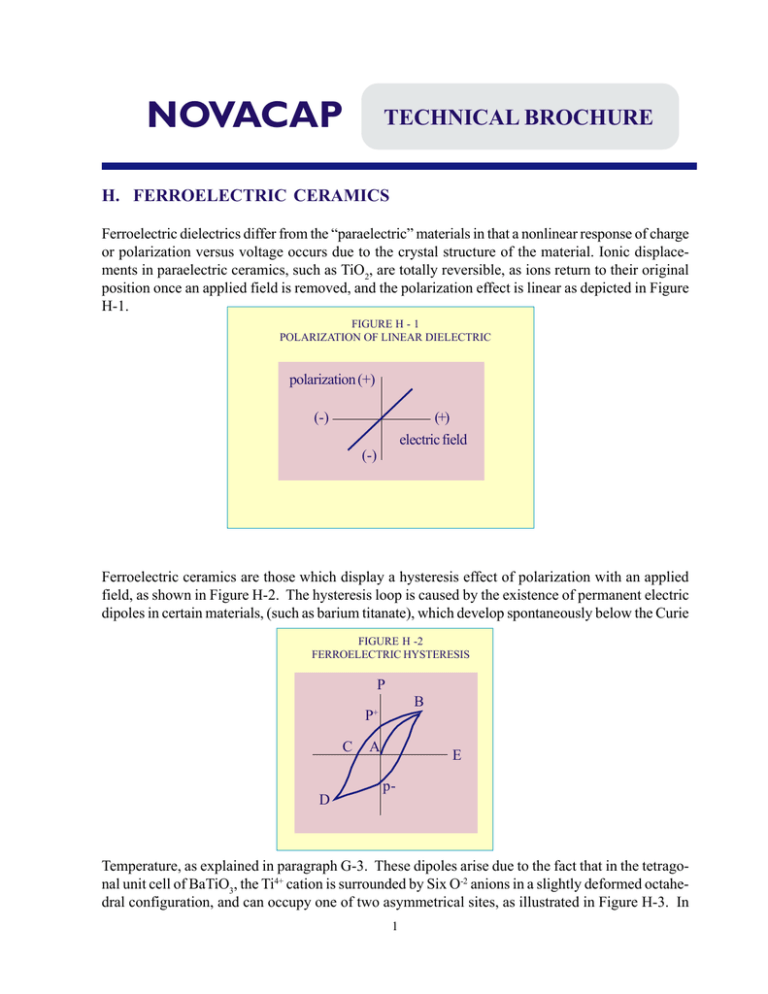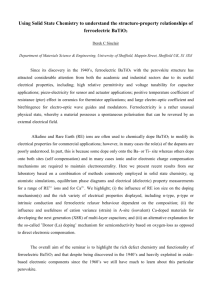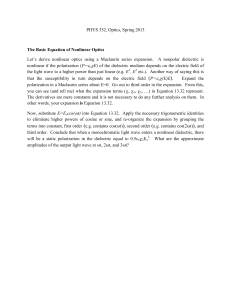Ferroelectric ceramics
advertisement

NOVACAP TECHNICAL BROCHURE H. FERROELECTRIC CERAMICS Ferroelectric dielectrics differ from the “paraelectric” materials in that a nonlinear response of charge or polarization versus voltage occurs due to the crystal structure of the material. Ionic displacements in paraelectric ceramics, such as TiO2, are totally reversible, as ions return to their original position once an applied field is removed, and the polarization effect is linear as depicted in Figure H-1. FIGURE H - 1 POLARIZATION OF LINEAR DIELECTRIC polarization (+) (-) (+) electric field (-) Ferroelectric ceramics are those which display a hysteresis effect of polarization with an applied field, as shown in Figure H-2. The hysteresis loop is caused by the existence of permanent electric dipoles in certain materials, (such as barium titanate), which develop spontaneously below the Curie FIGURE H -2 FERROELECTRIC HYSTERESIS P B P+ C D A E p- Temperature, as explained in paragraph G-3. These dipoles arise due to the fact that in the tetragonal unit cell of BaTiO3, the Ti4+ cation is surrounded by Six O-2 anions in a slightly deformed octahedral configuration, and can occupy one of two asymmetrical sites, as illustrated in Figure H-3. In 1 NOVACAP TECHNICAL BROCHURE either position, the Ti4+ cation is not coincident with the negative charge center of the oxygen anions by a small fraction of an Angstrom, creating an electric dipole. The energy barrier between the two possible Ti atom positions is sufficiently low to permit motion of the atom between sites by the coercion of an electric field, and the material can thus be directionally polarized with ease. The interaction between adjacent unit cells, in fact, is sufficient to create domains of parallel polarity the instant the material assumes its ferroelectric state on cooling through the Curie Point. FIGURE H - 3 Ti4+ CATION IN THE O2- OCTAHEDRON O2- Octahedron Positions for Ti4+ Upon creation, the ferroelectric domains are random in orientation, and the material has no polarization. In reference to Figure H-2, this state is equivalent to point A. If an external field is now applied, Ti atoms become displaced in the direction of the field, such that domains more favorably aligned with the field will grow, at the expense of those which are not, creating a rapid and major polarizing effect until a maximum orientation with the field is achieved (point B). Removal of the field at this point will eliminate any normal ionic polarization, but as is evident from the model of Figure H-3, the Ti atoms remain in their now oriented sites, and a remnant polarization (P+) isobserved. In order to remove this polarization it becomes necessary to apply an opposing field (point C) which reverts half the volume of the domains to favor the new field direction. Continuation of the field cycle inverts the polarization to a maximum (at point D) and removal of the negative field leaves a net polarization (P-). Further cycles of the electric field retrace the original path, creating a continuous hysteresis effect. A condition of zero polarization at 0 volts (point A) can only be again achieved by short circuiting the capacitor and heating past the Curie Point to generate a new system of random ferroelectric domains. Ferroelectric domains can actually be observed in polycrystalline barium titanate, where etched polished surfaces reveal differences in orientation on the grain structure of the material. The ferroelectric hysteresis loop varies in shape with temperature. At lower temperatures there is less thermal motion of atoms and a greater field is required to orient the domains. Measurements at higher temperatures show that the coercive field required for polarization decreases, until at the 2 NOVACAP TECHNICAL BROCHURE Curie Temperature the hysteresis effect disappears and linearity is approximated (Figure H-4). FIGURE H-4 HYSTERESIS LOOP AT VARIOUS TEMPERATURES -55oC 0oC 120oC 60oC It should be noted that barium titanate undergoes other phase transformations below the Curie Point, which are accompanied by changes in the dielectric constant of the ceramic. In addition to the cubic to tetragonal transformation on cooling through the 120°C Curie Point, a change from tetragonal to orthorhombic occurs at 0°C, which then transforms to the rhombohedral crystal habit at -90°C. The variation of the relative dielectric constant with temperature is illustrated in Figure H-5. FIGURE H - 5 TEMPERATURE COEFFICIENT FOR BaTiO3 dielectric constant 8000 6000 4000 2000 0 -100 -50 0 50 100 150 temperature, oC The variations of electrical properties of BaTiO3, in addition to the changes of these with temperature, present some obvious problems. The polarization obtained is a function of the electric field intensity, due to the energy required for domain orientation, i.e. K is a function of the applied field. 3 NOVACAP TECHNICAL BROCHURE In addition, the dielectric constant is highly temperature dependent and practical applications specify stability over a -55°C to 125°C temperature range. Also, as indicated previously, ferroelectric ceramics display aging and piezoelectric effects. There are, fortunately, other elements which can be incorporated into the BaTiO3 perovskite crystal structure to modify its properties. Lead titanate, for example, which also has a perovskite structure, readily forms solid solutions with BaTiO3, i.e. the Pb2+ cation can substitute the Ba2+ cation. Other partial substitutions for Ba2+, (such as Sr2+, Cd2+ and Ca2+), as well as replacement in part for the Ti4+ cation (by Sn4+, Zr4+, and Hf4+) are also used to modify the dielectric behavior and temperature dependence of BaTiO3. These additives greatly enhance the range of compositions and possible dielectric characteristics, and much effort has been expended in recent years to optimize these materials for practical applications. Specifically, additives are utilized to shift the Curie Point such that the high K properties of the ferroelectric can be put to work at or near room temperature. Examples of such materials are SrTiO3 and CaZrO3. Other materials may transfer the Curie Point to more elevated temperatures (PbTiO3). In addition to “shifter” additives, materials which depress the dielectric constant peak at the Curie Point are utilized, to provide a more stable K value over temperature. These compositional additives are call “depressors,” examples of which are MgZrO3 and Bi2Sn3O9. These materials are thus used in careful proportions to maximize the usefulness of the dielectric over the practical temperature range, i.e. the high K Curie peak is “shifted” towards room temperature, and the spike effect is depressed to provide a reasonable capacitance temperature coefficient. In polycrystalline ceramics many individual crystal characteristics can be combined which mask one another to provide relatively stable characteristics. Additions which do not form a solid solution, or only a partial solid solution with the host material, also affect the microstructure, by providing a second intergranular phase. Grain boundary phases which are not ferroelectric greatly affect the electrical properties of the composite, as these phases somewhat isolate the ferroelectric grains and thus inhibit domain interaction, depressing the dielectric constant, aging rate and the piezoelectric effects. In addition to the purposes described above, other ingredients are used to aid in fabrication of the multilayer capacitor, such as additives which flux the ceramic to permit sintering at lower and more reasonable temperature or inhibit excessive grain growth and provide denser microstructure. Often, minor percentages of certain oxides will determine other electrical properties, such as insulation resistance at 25°C, or at 125°C, or dielectric strength. 4





